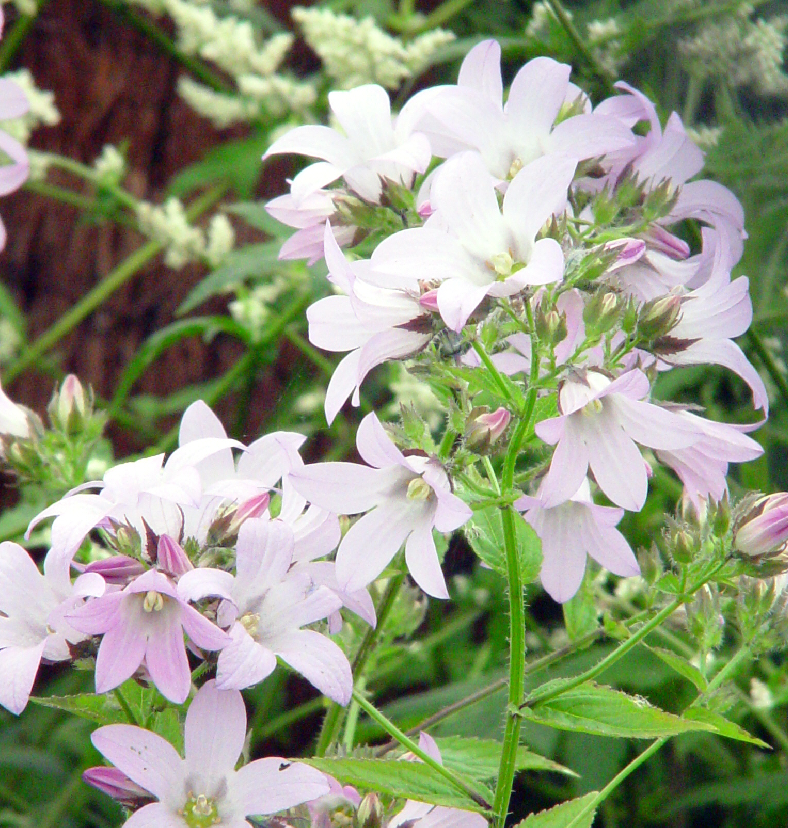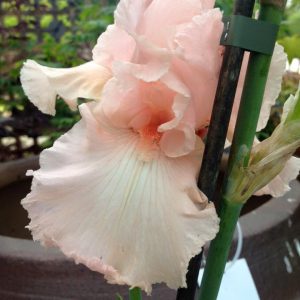Campanula lactiflora
Milky Bellflower.
Campanula lactiflora is an upright perennial with, narrow, toothed, mid-green leaves and large panicles of open bell-shaped soft lilac-pink flowers, on leafy stems.
Campanula lactiflora has a Max Height 1.2m. and a Max Spread 60cm. Flowers June to August. Full sun/partial shade. Hardy.
MORE
Campanula lactiflora, commonly known as the Milky Bellflower or the Giant Bellflower, is a herbaceous perennial plant that is native to central and eastern Asia, including China, Japan, and Korea. It belongs to the Campanulaceae family and is one of the most commonly cultivated species of the Campanula genus.
The plant typically grows to a height of 1-1.5 meters and spreads about 60 cm wide. It has a clump-forming growth habit and features attractive, lance-shaped leaves that are dark green in color and grow up to 15 cm long. The flowers are bell-shaped and range in color from pale blue to deep purple. They bloom in mid to late summer and attract bees, butterflies, and other pollinators.
Campanula lactiflora is a hardy plant that can tolerate a wide range of soil types, but it prefers well-draining soil that is rich in organic matter. It can be grown in full sun to partial shade and requires regular watering during the growing season to maintain its moisture levels. It is also relatively pest and disease-resistant, making it an easy plant to care for.
One of the most attractive features of Campanula lactiflora is its ability to produce tall spikes of flowers that are perfect for use in cut flower arrangements. The plant is also suitable for use in mixed borders, cottage gardens, and naturalized settings. When grown in large groups, it can create an impressive display of color and texture.
Propagation of Campanula lactiflora is typically done through division, which involves separating the clumps of the plant and replanting them in new locations. This should be done in the spring or fall when the plant is not actively growing. Seeds can also be collected from the flowers in the fall and planted in the spring.
In terms of maintenance, Campanula lactiflora requires regular deadheading to prolong the flowering period and prevent the plant from self-seeding. It should also be cut back to ground level in the fall after the first frost to encourage new growth in the following spring. Fertilizing the plant with a balanced fertilizer in the spring can also help promote healthy growth and flowering.
Campanula lactiflora has a long history of use in traditional Chinese medicine, where it is believed to have a number of health benefits. It is said to have anti-inflammatory, antispasmodic, and diuretic properties and is commonly used to treat conditions such as coughs, bronchitis, and urinary tract infections. While scientific research on these claims is limited, some studies have shown that Campanula lactiflora contains compounds that have antioxidant and anti-inflammatory effects.
In conclusion, Campanula lactiflora is a beautiful and easy-to-care-for perennial plant that is perfect for use in gardens and cut flower arrangements. With its tall spikes of bell-shaped flowers and attractive foliage, it can create an impressive display of color and texture in any setting. While it is primarily grown for ornamental purposes, it also has a long history of use in traditional Chinese medicine and may have some health benefits. Overall, Campanula lactiflora is a versatile and rewarding plant that is well worth growing.







Reviews
There are no reviews yet.